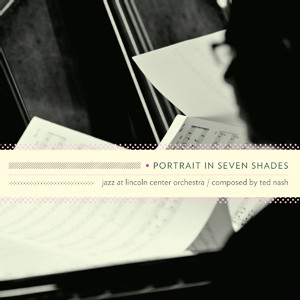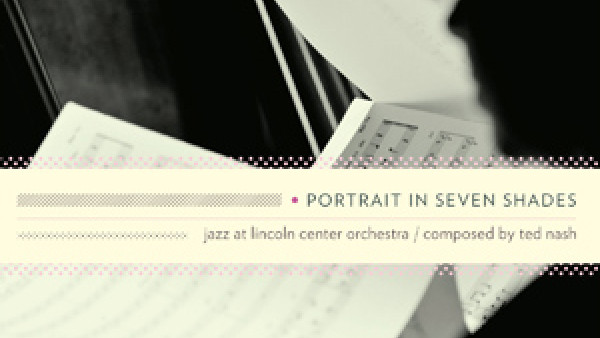Making Degas and Picasso Into Jazz Stars
Music is like a painting that exists in time; painting is like music that exists in space. Bringing them together was the worthy goal of “Jazz and Art,” a weekend concert series inspired by the collection at the Modern Museum of Art and presented this weekend at the Rose Theater by Jazz at Lincoln Center. The Jazz at Lincoln Center Orchestra was heard under the direction of multireed player — here called “guest conductor” — Ted Nash, who normally plays alto saxophone and flute with the band.
“Jazz and Art,” which featured giant slide projections of the art works behind the performers, was divided into two halves: works from the canon (none of which are regularly heard) in the first half, and a newly commissioned composition by Mr. Nash following the intermission. The first two pieces of the evening were by canonical jazz composers Duke Ellington and Coleman Hawkins — jazz’s equivalent of Rembrandt and Leonardo. Mr. Nash began unaccompanied with Hawkins’s 1948 “Picasso,” which is notable not only for the comparison that the father of the tenor saxophone drew between modern art and contemporary jazz, but for being the first widely known recording of a major horn player performing unaccompanied.
The bulk of the first half of Thursday’s performance was given to Ellington’s “Degas Suite” of 1968, an obscure work originally commissioned for the soundtrack of an uncompleted film and apparently only played by the Ellington band once in a recording session. Ellington was chiefly inspired by Edgar Degas’s famous paintings of racetrack scenes (such as his 1877 “At the Races”), and the suite is filled with the musical representation of galloping horses, suggested by, among other devices, drummer Ali Jackson’s tambourine.
You couldn’t have a show about jazz and art without an Ellington work: The Duke was a visual artist as well as jazz’s preeminent painter in musical sounds. Yet even lesser known Ellington is a hard act to follow, and other works suffer in comparison. Mr. Nash proceeded to play two works by his own approximate contemporaries — Maria Schneider’s “Some Circles” (for the Russian painter Wassily Kandinsky, from her first album, 1992’s “Evanescence”) and Jim McNeely’s “Cockiness,” for Paul Klee.
“Circles” suggested Kandinsky’s pioneering abstractions, played on Victor Goines’s vibrato-rich tenor and Wycliffe Gordon’s tuba, while Klee was depicted mainly by the trombonist Victor Gardner in a brief piece that frequently changed tempos and moods.
Mr. Nash’s “Portrait in Seven Shades” dominated the second half of the show. It is a wholly successful work, and, along with Wynton Marsalis’s “Big Train” (1999), easily the most enjoyable of the extended compositions written by a JALC orchestra member.
For “Portrait in Seven Shades,” Mr. Nash recruited several guest musicians, but more important, he utilized a multimedia conceit. His selections were directly inspired by the paintings of seven 20th-century artists (one of which was Vincent van Gogh, even though he died in 1890). Mr. Nash approached the project as much an interpreter as a composer, orchestrating the music according to what these famous images suggested and what he heard when he looked at them.
First up were Claude Monet’s classic impressions of water lilies, whose boldly impressionistic colors suggest such instrumental textures as Mr. Goines’s soprano saxophone and the composer’s flute. Mr. Nash used an Asian flute sound to underscore Monet’s Japanese footbridge.
For the surreal paintings of Salvador Dali, the composer combined ordinary elements in an incongruous way, setting discordant trumpets and trombones ever so slightly out of step with each other. Later, Dali’s famous melting clocks were underscored by an uncountable time signature that sounded like 4/4 and 5/4 at once.
The famous dancing women of Henri Matisse elicited Mr. Nash’s playful side; for these images he wrote a baritone saxophone piece that seemed very much in the style of the JALCO’s baritone virtuoso, Joe Temperley, but which was capably played by substitute Carl Maraghi. For Pablo Picasso, Mr. Nash began with the painter’s more traditional Spanish roots with a driving, flamenco-inspired trumpet solo by Mr. Marsalis, then portrayed his foray into abstraction and cubism by having the brass and reeds contrast one another in sharply drawn lines of call and response.
Two slightly offbeat sections followed, both involving guests: for van Gogh, Mr. Nash chose not to comment on the painter’s nascent modernism, but instead to offer a romantic tone poem on the nature of art itself. In the tradition of such classic Ellington suites as “Black, Brown, and Beige,” “The Perfume Suite,” and “The Liberian Suite,” he included a lyric, sung by his wife, the soprano Yola Nash.
The least successful movement of the seven was inspired by the Russian peasant village scenes of Marc Chagall. Mr. Nash brought in more guests here: Mr. Gordon on tuba, Bill Schimmel on accordion, and the violinist Marc O’Connor. The latter was singularly disappointing: He played the notes perfectly, but with little feeling and certainly nothing that suggested a Jewish shtetl. Why Mr. O’Connor was selected remains a mystery, since New York is filled with musicians who could have pulled this off.
The work climaxed with a successful movement inspired by five paintings from the 1940s and ‘50s by Jackson Pollock — the only American in the bunch. Pollock’s postmodern images apparently suggested to Mr. Nash the piano style of Lennie Tristano, which made it especially interesting, since Tristano’s music has almost never been adapted to big band proportions. Mr. Nash employed carefully controlled cacophony to mirror Pollack’s almost violent imagery and kept Mr. Schimmel on stage to play an otherworldly accordion solo.
“Portrait in Seven Shades,” whose success is due in no small part to the brilliance of the multimedia images, is a uniquely satisfying work, which, rare for an extended composition, doesn’t have a snooze in it. I only hope that when the JALCO records the piece, it’s released on a CD-ROM containing reproductions of the appropriate images. To have only the sound would be to have only half the experience.
by Will Friedwald
Source: The New York Sun



Comments
You’re quite welcome.
gloria on Mar 1st, 2007 at 11:04pm
thanks GLoria, you are wonderful !
Luigi Beverelli on Mar 1st, 2007 at 4:21pm
You know i was there opening night. You know I have tons to say. For now…
it was an incredible evening to see the art come alive and actually move–not in time with the music–but coming at the audience in slow, increasingly magnified images that brought the work into exquisite detail letting us see minuta we would have missed otherwise even if we already knew the works being displayed. There were three huge panels/projection screens that covered the entire back stage area.
The image would appear boldly, magnified across all three screens. We could not exactly tell which image was being displayed because of the magnification. So, the bold colors, details, brush strokes and paint textures were emphasized. The center screen featured an image of the framed work in its entirety, overlaying the magnification still displayed in the center screen. This allowed us to know which work was being displayed and to find visually the area that was being magnified across all three screens. It was a search and find, of sorts, and commanded our attention but in no way distracted from enjoying the art or the music.
Ted’s section on Van Gogh (I have all image titles and artists that were used) was brilliant. I cannot understand why/how the Sun reviewer thought so little of the violin player although there is no question, the accordian player was one with the gods that night. The energy of the music, the passion, and the space allotted for the improvisations was brilliant and in my opinion, could not have been better especially when coupled with the Van Gogh depicting an Eastern European ghetto scene.
ALl for all…rushing away as usual…I will post image titles so we can pull them from online and post here to go along with any of our discussion on jazz and art.
JG
Jurzy Girl on Feb 28th, 2007 at 7:02am
Interesting review. The process of creating music inspired by art and vice versa is not an easy one. Did anyone attend the show and can offer a different perspective?
Sonalii on Feb 27th, 2007 at 12:45pm